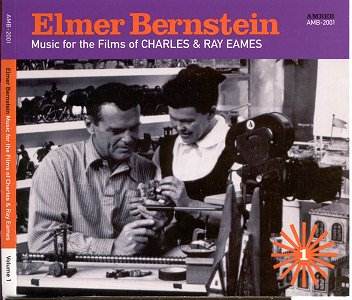Elmer BERNSTEIN Music for the
Films of Charles & Ray Eames  OSTs, conducted by the composer
OSTs, conducted by the composer  AMBER AMB-2001 [53:03]
AMBER AMB-2001 [53:03]

In 1952, Franz Waxman introduced a young Elmer
Bernstein to Charles and Ray Eames, a couple known for their contributions
to architecture and industrial design and whose creativity also
included industrial filmmaking. It was the start of a quarter-century
of collaboration, including the four works featured on this, the
first of several planned discs by Bernstein's Amber Records.
"Toccata for Toy Trains" is a 13-minute work
written in 1957 for a short film by the Eames focusing on -- yes,
toy trains. As with virtually all of Bernstein's collaborations
with the Eames, the score was written following discussions that
focused on a scenario, mood and characters, after which the composer
was left to himself to create. The result is music of pure enchantment
- a delightful mix of mostly peripatetic percussion and piping
winds that evokes a sense of motion and child-like joy. It probably
helps if, like me, you had a model train as a kid -- but if not,
you'll still find Bernstein's music here most infectious. (Side
note: While this is the original recording of the Toccata, it
isn't its premier release. Bernstein included a re-recording of
the work on his Filmmusic Collection album with his score to "The
Miracle" back in the mid-'70s.)
The second score, "Six Pieces for the Polavision
Movie Camera," is one of their last collaborations, coming in
1977. (Charles Eames died the following year, his wife 10 years
after that). It consists of separate musical vignettes for six,
2½-minute scenes depicting the various uses of a new "instant"
movie camera. Here again, Bernstein's compositional skills with
a small orchestra are displayed to great advantage as the pieces
range across a variety of moods. I particularly enjoyed his use
of harp in the delicate melody of the second piece, and the jazzy,
upbeat tempo that carries through the fourth piece.
These are followed by the seven-part "House:
After Five Years of Living," a film about the Eames' Southern
California home, built entirely with prefabricated materials.
Each of the short parts is a divertimento depicting a different
room. Composed for piano, harp, flute and cello - the smallest
ensemble represented on this disc - these seven pieces run barely
11 minutes in all. The moods here are not as wide-ranging as in
the previous work, but are essentially light and pleasant. Challenged
by the subject matter (the film contained only slide images, and
no dialogue) and a limited orchestral palette, Bernstein's music
emerges as the true star.
None of the first three scores, however, prepares
the listener for the final work, which is a true exercise in musical
frivolity and all the more enjoyable when taken in that light.
"Westinghouse in Alphabetical Order" was written in 1965 for,
of all things nonmusical, a stockholders' meeting! Faced with
the dilemma of explaining all of the company's many products to
its shareholders, the Eames decided to simply list each one alphabetically.
Bernstein was then provided with the typed list - it must have
run to many pages -- along with the problem of how to present
it musically. "It was difficult to get terribly excited about
electric knives, knife sharpeners ..., " he explains in the liner
notes. Finally, he hit on the idea of simply singing the list
in what he ultimately describes as "a pastiche cantata . with
tongue firmly in cheek."
These recordings, taken from the original tracks,
represent a side of the composer not often heard. Apart from his
occasional use of solo harp (which put me in mind, at one point,
of "The Great Escape,") there is little here that's immediately
suggestive of his better-known feature film scores. All of which
makes this limited-edition album - available from Amber Records
at www.elmerbernstein.com - all the more interesting.
For Bernstein fans, this is a must. Others should
find it an enjoyable listen. In all, Bernstein wrote music for
about 30 of the Eames films. A second volume CD is eagerly awaited.
John Huether

